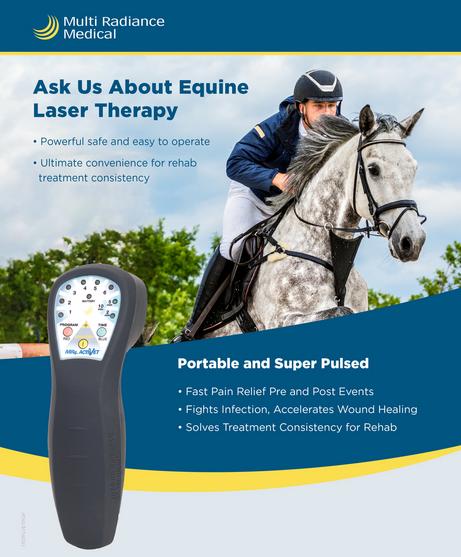Laser Therapy in Horse Treatment: A Modern Approach to Improving Steed Wellness
Laser treatment has emerged as a crucial technique in equine treatment, making use of concentrated light power to promote mobile repair and accelerate recuperation from a variety of disorders. By promoting mitochondrial task and increasing ATP manufacturing, laser treatment not only boosts blood circulation however additionally offers considerable pain relief.
Recognizing Laser Treatment
Laser treatment, a non-invasive therapy method, has actually gotten considerable traction in equine medicine due to its effectiveness in advertising recovery and discomfort alleviation. Improved ATP levels quicken tissue repair processes and minimize inflammation, making laser treatment especially reliable for dealing with bone and joint injuries, wounds, and various other inflammatory problems in equines.
There are several kinds of lasers utilized in equine therapy, each with specific wavelengths and power results tailored to various restorative needs. Low-level laser treatment (LLLT), likewise called cool laser therapy, uses reduced power levels to promote cell function without creating thermal damage. High-intensity laser treatment (HILT), in contrast, uses higher power degrees to achieve deeper cells penetration and even more significant healing impacts.
Veterinarians utilize numerous laser gadgets and methods depending on the problem being treated and the preferred depth of cells infiltration. Correct training and expertise are crucial for making certain the secure and reliable application of laser therapy, thereby maximizing its therapeutic possibility while lessening risks.
Benefits for Horse Health And Wellness
With a strong understanding of exactly how laser therapy works, it is essential to explore its various benefits for equine health. By stimulating cellular function, laser therapy promotes faster wound healing and aids in the regeneration of damaged tissues.
Additionally, laser treatment has actually been revealed to boost blood circulation, thereby improving blood circulation to influenced locations. Improved circulation guarantees that important nutrients and oxygen are delivered much more efficiently, promoting the recovery procedure. Furthermore, laser treatment's anti-inflammatory impacts assist in decreasing swelling and discomfort, which is important for the general well-being of the horse.
Pain monitoring is an additional significant benefit. By launching endorphins and obstructing pain signals, laser treatment provides reliable, non-invasive remedy for both acute and persistent pain. This can add to enhanced mobility and top quality of life for the animal.
Last but not least, laser therapy is a non-invasive therapy choice, decreasing the danger of complications linked with more intrusive procedures. Its adaptability and efficacy make it an important device in modern equine vet medicine.
Typical Conditions Treated

An additional widespread problem treated with laser treatment is joint inflammation. Furthermore, laser therapy is employed in the management of wounds.
Horse respiratory system problems, such as recurring respiratory tract blockage (RAO), likewise respond favorably to laser therapy. The anti-inflammatory residential properties of the therapy aid in decreasing air passage inflammation, thus improving respiratory feature. In addition, laser treatment is beneficial in treating unguis troubles, consisting of laminitis and abscesses. By improving circulation and minimizing pain, it sustains quicker healing.
Treatment and Safety
Applying laser therapy in equine therapy involves a meticulous procedure to make sure both effectiveness and safety and security. Equine Therapy. The procedure starts with a thorough veterinary assessment to figure out the viability of laser therapy for the steed's certain problem. As soon as deemed proper, the treatment location is prepared by cleansing and, if necessary, clipping the hair to enhance laser penetration
The practitioner has to pick the proper kind of laser, typically a low-level laser (LLLT) or a high-power laser (HPL), depending upon the condition being dealt with. The laser tool is then adjusted to the appropriate wavelength, power, and duration setups. Throughout the application, the practitioner relocates the laser over the targeted location in a systematic fashion, making certain constant and even direct exposure.
Security procedures are strictly abided by, including using protective eyewear for both the practitioner content and the horse. Additionally, it is important to check the horse for any indicators of pain or adverse responses throughout the treatment. Post-treatment, official website the steed is usually offered a duration of rest to allow the restorative impacts to materialize.

Future of Equine Laser Therapy
As innovations in veterinary medicine remain to unravel, the future of equine laser therapy holds considerable guarantee. Emerging modern technologies and deeper scientific insights are readied to refine and increase the applications of laser treatment for horses. Among the most expected developments is the integration of innovative imaging techniques that enable a lot more exact targeting of damaged tissues, consequently enhancing restorative outcomes. Additionally, the development of mobile and user-friendly laser tools is likely to make this therapy extra available to a more comprehensive variety of professionals and horse proprietors.
Furthermore, continuous research into the molecular and cellular systems of laser treatment will likely generate maximized procedures tailored to particular conditions, enhancing performance and decreasing therapy times. Personalized treatment plans based on genetic and biochemical markers might come to be a reality, guaranteeing that each equine gets one of the most ideal and reliable treatment.
Additionally, governing developments and standardization of methods will certainly enhance the integrity and integrity of laser treatment in equine technique. Equine Therapy. As these innovations proceed to emerge, equine laser treatment is poised to become a vital element of vet treatment, offering improved healing and enhanced lifestyle for equines internationally
Final Thought
